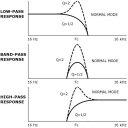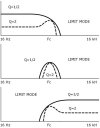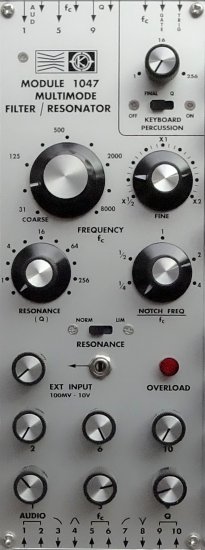
1047
Multimode Filter
The MOS-LAB 1047 consists of a highly resonant filter with voltage controlled frequency and resonance, and simultaneously provides high-pass, band-pass, low-pass, and notch outputs. The filter is capable of providing a side variety of formant shaping and tonal modulation. The band-pass response is that of a natural acoustic resonator, and is most useful in synthesizing instrumental timbres. In addition, the high degree of resonance and frequency tracking accuracy attainable enables the filter to perform precise, narrowband spectrum analysis of audio signals.
The center frequency of the band-pass output is the cutoff frequency of the high-pass and lowpass outputs, and is referred to as ”Fc”. Fc may be set by the coarse and fine frequency knobs over the range of 16 Hz to 16 kHz. Control signals applied to any Fc input will change the center frequency from the knob setting by 1 octave per volt when the knob above the control input is at maximum. Control signals from the individual inputs are summed with the Fc knob controls, and may be positive, negative, or audio.
With the RESONANCE (Q) knob at minimum and the RESONANCE switch set to ”NORM”, the band-pass output has a gain of 0.5 at Fc and attenuates 6 dB per octave above and below Fc. The high-pass output has unity gain from Fc to close to the Nyquist frequency at 48 kHz and attenuates 12 dB per octave below Fc. The low-pass output has unity gain from DC to Fc and attenuates 12 dB per octave above Fc. The notch output has flat response everywhere except for a deep notch at a frequency determined by the NOTCH FREQ / Fc knob. With this knob set to 1, the notch occurs at Fc. NOTE: The notch output is effective only at low Q.
As the RESONANCE (Q) knob is turned up, a resonant peak occurs at Fc in all four outputs, except in the notch output when the notch frequency is at Fc. The gain at this peak is numerically equal to the ”Q”, and the 3 dB bandwidth of this peak is equal to Fc/Q. Thus, as Q is varied from 1/2 to 512, the bandwidth varies from 2 Fc (2 octaves) to Fc/512 (1/32 of a semitone). When using high resonance, the audio input controls may have to be turned down to prevent overload.
An overload light is provided for this purpose. The Q may be controlled by external signals. The Q control characteristic is exponential; that is, each volt applied to a ”Q” input doubles the Q when the input know is at maximum.
With the RESONANCE switch set to ”LIM”, the height of the resonant peak is limited to unity gain at Fc, and the response on either side falls off as the Q is increased. This mode is useful when tuning sharply about a strong fundamental or harmonic of the input signal, but will otherwise result in a very low output signal at high resonance. For most applications, this switch should be set to ”NORM”.
The front panel has an extra input jack marked ”EXT INPUT”, which is mixed with the lower matrix switch audio inputs.
Keyboard percussion allows the filter to generate a wide variety of percussive tones from the keyboard. The keyboard gate and trigger output should be connected to the GATE and TRIGGER inputs at the upper right corner of the panel, and the keyboard control voltage applied to any one Fc input. With the KEYBOARD PERCUSSION switch on, striking a key produces a sharp percussive attack followed by a tone which varies from a slightly pitched click resembling a castanet clap (at low Q) to a slowly decaying sine one at high Q. Upon releasing the key, the tone damps at a rate determined by the FINAL Q knob. The band-pass output gives the most natural percussive quality, although the high-pass and low-pass outputs may be used. They give a sharper and a duller attack, respectively.








